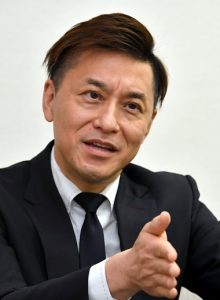Hiroshima Voices: “No Nukes, No War” Tetsuya Matsuda, 53, second-generation A-bomb survivor, company executive, Naka Ward, Hiroshima
Dec. 28, 2022
Recovery from nothing amid ruins
Tetsuya Matsuda is chairperson of Hiroshima Mazda, an automotive sales company based in Hiroshima’s centrally located Naka Ward. His grandfather, the original founder of Mazda the car company, and all seven employees at that time were killed in the atomic bombing. Mr. Matsuda’s father went into the city and was exposed to A-bomb radiation. In 2016, Mr. Matsuda purchased a building next to the A-Bomb Dome, in the city’s Naka Ward, renovated it and opened what is called the Hiroshima Orizuru Tower. He throws his energy into passing on the culture of Hiroshima through involvement in an online paper lantern floating ceremony on the anniversary of the atomic bombing and in efforts to return the Hiroshima Great Buddha statue (in Japanese, ‘Daibutsu’) to the city.
Click here to view the video
When I got a look at the view from the rooftop for the first time before purchasing the Hiroshima Orizuru Tower building, I was forced to think back to the time of the atomic bombing. I saw the Shima Hospital (now the Shima Hospital of Internal Medicine) at what was the hypocenter, as well as Aioi Bridge, which served as the target of the bombing. I was impressed by the contrast between the A-Bomb Dome and the current cityscape. I hope people will come to Hiroshima from all over the world. I want them to see the Hiroshima that recovered from amid ruins, from here at this spot.
Our company lost its founding president, employees, and buildings in the atomic bombing. From scratch, surviving relatives of our family rebuilt the company, which grew along with the recovery of Hiroshima’s economy. Something in our very DNA makes us want to do something for Hiroshima out of gratitude.
Nevertheless, I have heard some people question whether it was my intent to look down on the A-bomb Dome from on high in the Orizuru Tower. I have never experienced war and as such am not in a position to loudly proclaim the meaning of peace. While I was at a loss about how to deal with this issue, one of our employees gave me an idea for the Orizuru Wall. That concept involves visitors folding paper cranes and placing them in a glassed-in space. People of any country, religion, or ideology can participate, and their wishes for peace accumulate there. It is similar to the way Hiroshima has accepted the thoughts and feelings of so many different people. The donated paper cranes will soon number 800,000.
The atomic bomb destroyed our culture and traditions. To continue passing on the wishes of Hiroshima, we came up with the idea of holding an online version of the paper lantern floating ceremony on the 75th anniversary of the atomic bombing in 2020, a year in which the traditional annual ceremony had been canceled due to the coronavirus pandemic. This year, we welcomed back to the city the Hiroshima Great Buddha, which had been enshrined near the A-bomb Dome during the reconstruction period and was later moved to Nara Prefecture.
Next May, in 2023, the summit meeting of the G7 (Group of Seven industrialized nations) will be held in Hiroshima City. I hope the meeting can serve as an opportunity for people from Russia to also visit the city. We should not just confront each other with force and sanctions; we also need to foster dialogue by agreeing to disagree. Isn’t that the role of Hiroshima and Japan, places that experienced the ravages of war as well as recovery? (Interviewed by Yuki Kuwata)








